How Do You Repair Plastic Car Bumpers?
Seeing a scuff or crack on your car’s plastic bumper can be frustrating. Does that mean you’re stuck with the damage or facing an expensive replacement?
You can repair many types of damage on plastic car bumpers yourself, saving money and restoring your car’s appearance. Common repairs include fixing scratches, dents, and small cracks using readily available tools and materials.
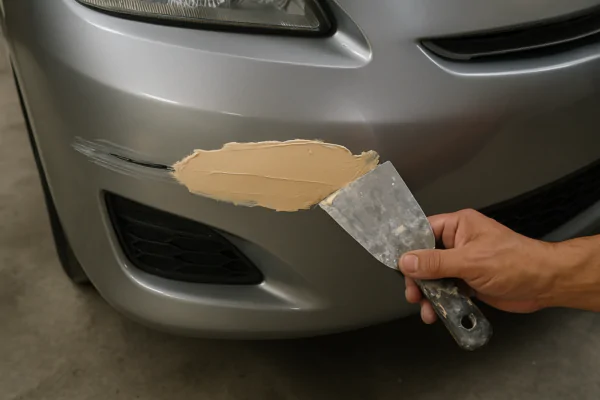
Repairing a scratch on a plastic car bumper.
Repairing a plastic bumper is a rewarding DIY project. It requires patience and the right techniques, but it is definitely achievable for most people. Let’s break down the steps involved in bringing your bumper back to looking good.
Can Plastic Auto Bumpers be Repaired?
It’s a common question. Plastic seems fragile, so can it really be fixed after a bump or scrape?
Yes, plastic auto bumpers can be repaired in most cases. The extent of the repair depends on the severity of the damage, but minor issues like scratches, scuffs, small dents, and even cracks can be effectively fixed using specific plastic repair products and techniques.
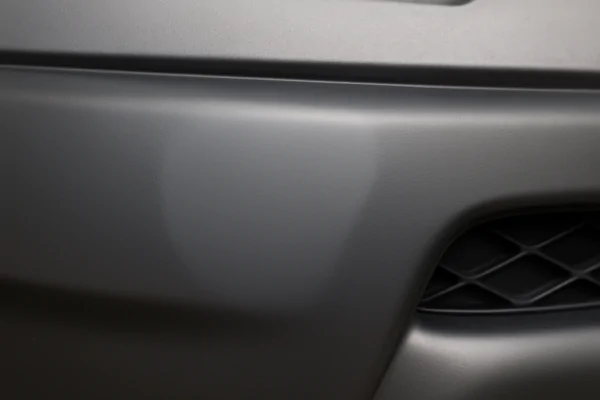
A repaired and smoothed section of a plastic bumper.
Modern car bumpers are designed to absorb impact, and they are typically made from flexible plastic materials like polypropylene (PP) or polyurethane (PUR). These materials can deform without breaking completely, which makes them suitable for repair. For simple scratches and scuffs, the repair process often involves cleaning the area, sanding to smooth out the imperfection, filling if necessary, and then repainting. Dents can often be pushed out from behind, sometimes with the help of heat to make the plastic more pliable. Cracks require a more involved process, often involving plastic welding or using specialized two-part epoxy adhesives specifically designed for plastic repair. These epoxies create a strong bond that can withstand the flexing of the bumper. The key is to use products that are compatible with the type of plastic your bumper is made from. You might find a code on the back of the bumper indicating the plastic type. While professional repair shops have specialized equipment for plastic welding and shaping, many effective DIY kits and products are available for common repairs. Preparing the surface properly is crucial for any repair to last. This includes thorough cleaning and using the correct grit sandpaper from NOVOGRIT to create a surface that the repair material can adhere to properly.
How to Sand a Plastic Bumper?
Sanding is a critical step in almost any plastic bumper repair, from smoothing out scratches to preparing for filler or paint. But sanding plastic is different from sanding metal or wood.
To sand a plastic bumper effectively, you need to use the right type of sandpaper and techniques that prevent melting or distorting the plastic. Start with a coarser grit to remove material or imperfections, and then progressively move to finer grits to smooth the surface.
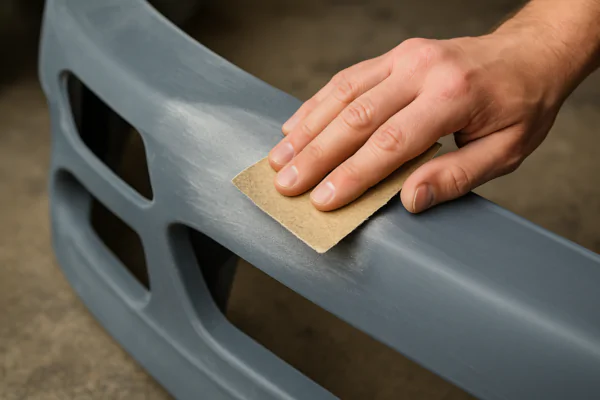
Sanding a plastic car bumper during repair.
Sanding plastic requires a gentle touch because excessive heat generated by friction can melt or deform the material. This is especially true with power sanders, so hand sanding is often preferred for plastic bumper repairs, at least for the initial stages. When using sandpaper, it’s important to use paper designed for automotive use, as it is often more durable and clog-resistant. NOVOGRIT offers a range of sandpaper suitable for plastic, including film-backed discs that are very flexible and resistant to tearing. Start with a grit that is coarse enough to remove the imperfection you are targeting. For deep scratches or to level filler, you might start with something like 180 or 240 grit. Sand in a consistent pattern, either back and forth or in a crosshatch pattern, making sure to feather the edges of the repair area into the surrounding paint. This creates a smooth transition. As you sand, you will notice plastic dust being created. It is important to clear this dust frequently to prevent it from clogging the sandpaper, which makes it less effective and can cause scratching. You can wipe it away with a clean cloth or use compressed air. Once you have removed the major imperfection with the coarser grit, switch to a finer grit, like 320 or 400, to refine the surface and remove the scratches left by the previous grit. Continue progressing through finer grits, such as 600 and then maybe 800 or 1000 grit, depending on whether you plan to apply filler primer or paint directly. For preparing for a final clear coat, you might even go up to 1500 or 2000 grit, often using wet sanding at these final stages to achieve maximum smoothness. Always clean the area thoroughly between grit changes to remove all dust particles.
Conclusion
Repairing plastic car bumpers is a practical skill that can save you significant costs. By understanding how to address different types of damage and properly sanding the area with quality abrasives like NOVOGRIT, you can effectively fix your bumper and restore your car’s appearance.
You may also be interested in:

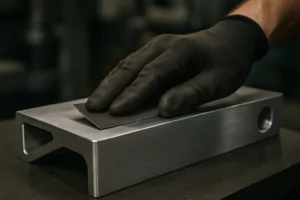
Best Sandpaper for Aluminum: NOVOGRIT's Guide to Flawless Finishes
What is the Best Type of Sandpaper to Use on Aluminum? Do you find yourself frustrated by sandpaper that gums up instantly when you try to smooth aluminum? It is
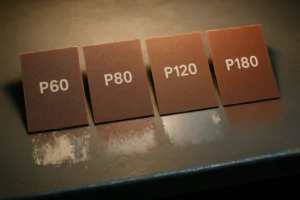
Best Sandpaper for Paint Removal: Grits, Types, & Tips | NOVOGRIT
What is the Best Sandpaper for Removing Paint? Are you tired of staring at chipped, peeling paint on your furniture, walls, or even your car? It’s a common problem, and
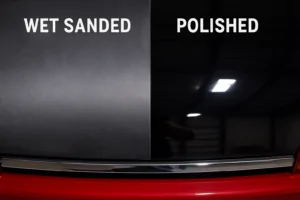
Automotive Wet Sanding: Supplies, Liquids & Best Sandpaper
Automotive Wet Sanding Supplies: What Do You Really Need? Wet sanding is a crucial technique in automotive refinishing, used to achieve a flawlessly smooth surface before painting or polishing. Unlike
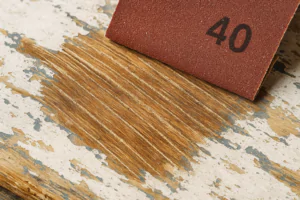
Best Sandpaper for Paint Removal & Grit Guide
What Is the Best Sandpaper for Removing Paint? Removing old paint can be a tedious job, but using the right sandpaper makes all the difference. It’s not just about grit;
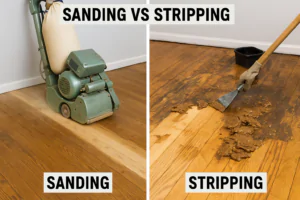
Hardwood Floor Sanding: Screen vs. Sandpaper & Best Practices
Sanding Screen vs. Sandpaper for Hardwood Floors: Which is Best? When you’re tackling hardwood floor projects, choosing the right abrasive is crucial for achieving a smooth, professional finish. Both sanding
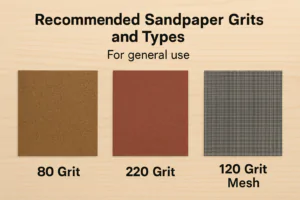
Paper Backing vs. Mesh Sanding Discs: Which Abrasive to Choose?
Paper Back vs. Mesh Sanding Discs: Which One Should You Pick? Choosing the right sanding disc backing can significantly impact your project’s efficiency and finish quality. Paper-backed discs are a
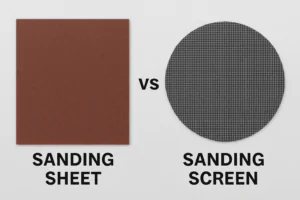
Sanding Mesh vs Paper: Which is More Economical and Better?
Is Sanding Mesh More Economical Than Sandpaper? Comparing Abrasive Costs When stocking up on abrasives, cost is always a factor. Paper sandpaper has traditionally been the standard, but newer mesh
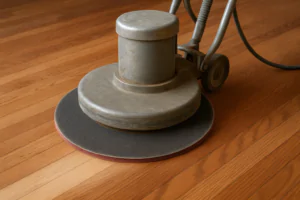
Sanding Nets & Screens Use Cases: When to Choose Mesh Abrasives
Sanding Nets and Screens: What Are Their Best Use Cases? When you encounter sanding nets or screens, you might wonder where they fit into your sanding projects. Unlike traditional solid-backed
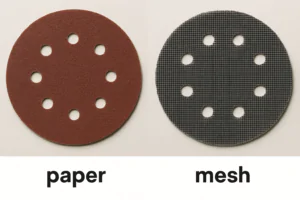
Paper vs. Mesh Sanding Discs: Which Abrasive to Choose?
Paper vs. Mesh Sanding Discs: Which Should You Buy? Choosing the right abrasive disc is essential for efficient and effective sanding. Two primary types dominate the market: traditional paper-backed discs
